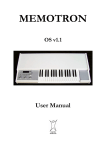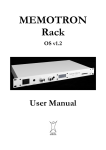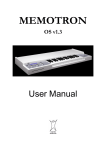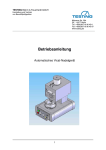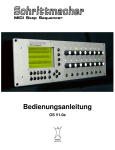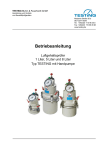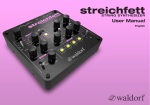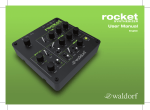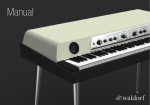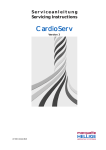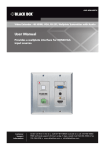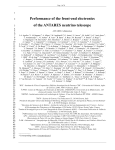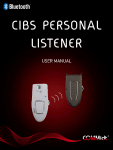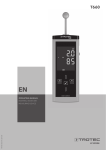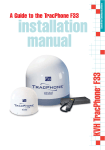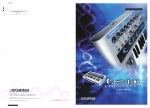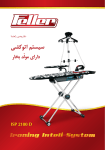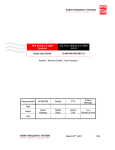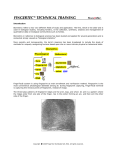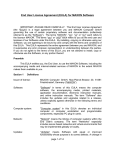Download User Manual
Transcript
User Manual OS V1.0c Preface Thank you very much for buying the Schrittmacher from Manikin Electronic. The Schrittmacher extends your music studio by an exceptionally high-performance step sequencer. It allows you intuitive generation of sequences and grooves. Play with it and discover for yourself the new possibilities of step sequencing. We hope you will get many ideas for your music by working with your new sequencer: Enjoy using it. The Schrittmacher’s development team Thorsten Feuerherdt : Hardware, housing, design, manual Markus Horn : Software, design, manual Mario Schönwälder : Manual, Beta test Detlef Keller : Beta test Helga Busch : Translation Version : 1.0c, July 2006 Our special thanks to Klaus Schulze, Bas B. Broekhuis, Till Kopper, Thomas Fanger, Andreas Schneider, Pamela und Nele, Kathja and Niels, … as well as everybody else we may have forgotten to mention here. Note Manikin Electronic will not assume any responsibility for errors which may occur in this manual. The contents of these instructions is subject to change without prior notice. When this manual was created good care was taken to exclude any mistakes and contradictions. Manikin Electronic will not accept any guarantees for this manual except those provided by commercial law. No part of this user manual is allowed to be reproduced without the express written consent of the manufacturer. Manikin Electronic, Attilastraße 87k, D-12247 Berlin, Germany Schrittmacher - Manual 1 Table of contents Preface....................................................................................................................... 1 The Schrittmacher’s development team................................................................................. 1 Our special thanks to ............................................................................................................. 1 Table of contents ...................................................................................................... 2 Operating elements & connections......................................................................... 4 Front panel ............................................................................................................................ 4 Back panel............................................................................................................................. 5 Introduction ............................................................................................................... 6 About this manual .................................................................................................................. 6 Symbols used ................................................................................................................... 6 Marking of parameters ...................................................................................................... 6 General safety notes.............................................................................................................. 7 Suitable location................................................................................................................ 7 Mains connection .............................................................................................................. 7 Operation .......................................................................................................................... 7 Maintenance ..................................................................................................................... 7 Proper use ........................................................................................................................ 7 Setup.......................................................................................................................... 8 Parts supplied........................................................................................................................ 8 Installation ............................................................................................................................. 8 Connections........................................................................................................................... 8 Basic Operation ........................................................................................................ 9 Power ON.............................................................................................................................. 9 Power OFF ............................................................................................................................ 9 Playing sequences ................................................................................................................ 9 Input using the endless dials.................................................................................................. 9 Working with the Schrittmacher ............................................................................ 10 Selecting a line .................................................................................................................... 10 Editing a line ........................................................................................................................ 10 Editing the step values .................................................................................................... 10 Editing the step modes.................................................................................................... 10 Editing the line parameters.............................................................................................. 11 Linking lines......................................................................................................................... 11 Line Parameters .................................................................................................................. 13 Type................................................................................................................................ 13 Mode............................................................................................................................... 15 First, Last ........................................................................................................................ 15 Sync Mode, Sync Base ................................................................................................... 15 Gate ................................................................................................................................ 15 Len.................................................................................................................................. 15 Midi ................................................................................................................................. 16 Vel................................................................................................................................... 16 Add ................................................................................................................................. 16 2 Schrittmacher - Manual ID .................................................................................................................................... 16 Editing aids.......................................................................................................................... 17 Add ................................................................................................................................. 17 Rotate ............................................................................................................................. 17 Setup Menu ............................................................................................................. 18 MIDI Settings ....................................................................................................................... 18 Information .......................................................................................................................... 20 Preset Menu ............................................................................................................ 21 Load Preset ......................................................................................................................... 21 Save Preset ......................................................................................................................... 22 Init Preset ............................................................................................................................ 23 Dump Preset........................................................................................................................ 23 Other Functions ...................................................................................................... 24 Preload Preset..................................................................................................................... 24 Sync .................................................................................................................................... 24 Loop .................................................................................................................................... 24 Step mode ........................................................................................................................... 24 Global .................................................................................................................................. 25 Updating the operating software .......................................................................................... 26 Annex....................................................................................................................... 29 Time and clock table............................................................................................................ 29 Technical data ..................................................................................................................... 30 MIDI implementation chart ................................................................................................... 32 Glossary .............................................................................................................................. 33 Schrittmacher - Manual 3 Operating elements & connections Front panel 1 2 3 4 6 7 10 4 8 11 5 9 1. Display 2. Sequence buttons for selecting the active sequence range 3. Endless dial with LEDs to edit the 16 steps 4. Cursor buttons 5. Line buttons to select the active line 6. Power button 7. Sync, Loop and Step mode button 8. Global button 9. Enter and Escape 10. Preset and Setup menus 11. Start, Stop and Pause Schrittmacher - Manual Back panel 1. 2. 3. 4. 5. Voltage supply socket for the connection of the supplied power supply LCD contrast MIDI IN socket to receive MIDI data MIDI OUT socket A to transmit MIDI data MIDI OUT socket B to transmit MIDI data Schrittmacher - Manual 5 Introduction Even if you are a professional in using studio equipment and sequencers it will be useful to read this user manual right through to the end. The Schrittmacher features many new functions never before implemented in a hardware sequencer. About this manual This manual is intended to make the first steps for using the Schrittmacher easier for you. Moreover it also provides support and tips to the experienced user for his daily work. For simplicity’s sake all technical terms in these instructions are identical with the Schrittmacher’s parameter designations. Symbols used To ensure a better overview, this manual uses standardized spelling and symbols which are explained below. Important notes are highlighted in bold print. ! Attention – Pay special attention to this note to avoid malfunctions. i Gives some short additional information. ⇒ Instructions – Observe these instructions to execute the requested function. Marking of parameters All designations of buttons, controllers and parameters of the Schrittmacher in the text are highlighted in bold print. Example: Press the Power button. The value range permitted for parameter setting is highlighted by indicating the maximum and minimum values in italics separated by three dots. Settings which cannot be represented by a value range are separated by a comma. Example: Midi 6 A01 ... A16, B01 ... B16 Schrittmacher - Manual General safety notes Please read the safety notes below very carefully. They comprise some basic rules for the use of electric devices. Please read all the notes before you start using the device. Suitable location • • • • • • Only operate the device in closed rooms. Never operate the device in humid environments such as bathrooms, washing rooms or swimming pools. Do not operate the device in extremely dusty or dirty environments. Ensure unhindered air supply to all sides of the device. Do not place the device in close proximity of heat sources such as radiators. Do not expose the device to direct sunlight. Do not expose the unit to heavy vibration. Mains connection • • • • • Only use the supplied connection cable. If the supplied mains connector does not fit into your socket you should consult a qualified electrician. Disconnect the mains connector from the socket if you do not use the device for a longer period of time. Never touch the mains connector with wet hands. When disconnecting, always pull the connector and never the cable. Operation • • • Never place any vessels containing liquids on top of the device. Ensure that the device cannot move during operation. Use a solid base or a suitable built-in rack (19‘‘ format). Ensure that no objects can get inside the device. Should this happen against all odds, switch the device off and disconnect it from the mains. Then contact a qualified supplier. Maintenance • • Do not open the device. Any repair or maintenance should be done by qualified personnel only. There are no parts inside the device that could be maintained by the user. You will also lose your right to claim warranty if you open the device. Only use a dry, smooth cloth or brush for cleaning the device. Do not use any alcohol, solvents or similar chemicals. They will damage the surfaces. Proper use This device is exclusively intended for creating and processing control signals according to the MIDI standard. Any other use is not permitted and will exclude any warranty claims towards Manikin Electronic. Schrittmacher - Manual 7 Setup Parts supplied Please check when unpacking if all parts are included. Should something be missing contact your specialist supplier immediately. The Schrittmacher is supplied with: • • Power supply with cable, this manual. We recommend to keep the original packaging for further transports. Installation Place the Schrittmacher on a clean, even base. Installation in a solid 19" rack is recommended. The required space for the height is 132mm which corresponds to 3U. The installation depth is 85mm. Connections You need a mains outlet and at least one sound generator with MIDI interface. i ⇒ The Schrittmacher allows internal generation of transposing and other MIDI control commands. However, the fun factor in using the Schrittmacher for your work will be increased by at least 10000%, if a master keyboard whose MIDI controllers can be freely assigned is connected to the MIDI input. How to make the necessary connections: 1. Ensure that the Schrittmacher and your MIDI devices are switched off. 2. Connect the supplied mains cable to the mains connector into a suitable mains outlet. 3. Connect the MIDI outputs of the Schrittmacher to the MIDI inputs of the sound generator. 4. Connect the MIDI input (MIDI IN) of the Schrittmacher to the MIDI output of a master keyboard (not required). 5. Switch the Schrittmacher and your MIDI devices on. 6. Continue with the chapter “Basic Operation“ on the next page. 8 Schrittmacher - Manual Basic Operation Power ON For Power ON press the Power button. After being switched on the Schrittmacher needs a few seconds to initialize. Power OFF To switch the device off press the Power button and keep it pressed until the device is separated from the mains. The off-delay of approx. 5 seconds is to prevent unintentional switching off. Thus pressing the Power button briefly will not result in an unintended and possibly embarrassing stop during a live concert. Playing sequences By pressing the Start button the loaded preset is started. All active lines of the 4 sequence ranges will now create MIDI events which are sent via the MIDI outputs. A running preset can be stopped by pressing the Pause button with the preset not being reset. By pressing the Start button again playing of the preset will be continued starting from that point where it was stopped. Using the Stop button you will stop playing and reset the preset to the initial position. Input using the endless dials The endless dials used in the Schrittmacher do not have an end stop position – as opposed to potentiometers. They also have a pushbutton. Depending on the assigned function, parameters can be input using the endless dials: Editing parameters By turning an endless dial clockwise, the respective value is incremented. By turning it counter-clockwise the respective value is decremented. By pressing the endless dial the mode of a step (play / mute / skip) can be changed. It depends on the set step mode between which modes you can change. For more information read the “Step Mode” section on page 24. Menu navigation You can mark a menu item using the endless dial 9. By turning it clockwise you move the marking downward. By turning it counterclockwise you move it upward. Alternatively you can also move the . marking using the cursor buttons You can select the menu item by pressing the endless dial or the Enter button. You exit the menu without making any selection by pressing the Esc button. i When an endless dial can be used for a selection function, the respective LED lights orange. Schrittmacher - Manual 9 Working with the Schrittmacher After Power ON an initialized preset with a note line is loaded. All other lines are OFF. In the display you see the line that has been selected, the preset name, the play mode, the speed, the values of the 16 steps as well as the line parameters. Selecting a line The Schrittmacher has 4 separated sequence ranges between which you can change using the Sequence buttons. In each range there are 8 lines between which can be changed using the Line buttons. Once you have selected a line by means of the Sequence and Line buttons you can process the 16 steps and the line parameters of this line using the endless dials. The LEDs integrated in the Sequence and Line buttons indicate which line has been selected for editing. Alternatively there is an indication on the top left which line has been selected: for example, ”S2 | L3“ means that you are editing the third line in the second sequence range. Editing a line Using the 16 endless dials allows you to edit the steps of the selected line. Editing the step values The value of a step is incremented by turning the endless dial clockwise. This means that the value is decremented if the endless dial is turned counter-clockwise. To cross very large value ranges some acceleration has been integrated – i.e. the faster the endless dial is turned, the more values are skipped. Editing the step modes The mode of a step (play, mute/hold, skip) is indicated by a bi-colored LED above the endless dial: • • • green red off the step is played the step is set to mute or holds the last value the step is skipped Switching from one step mode to another is ensured by pressing the respective endless dial. When pressing the Step mode button you select changeover between play and mute or play and skip. The step mode is indicated by the integrated LED: • • green off changeover between play and mute/hold changeover between play and skip The current step is lit while all other steps are dimmed. 10 Schrittmacher - Manual Editing the line parameters To edit the line parameters you have to start by pressing the Enter button. The LEDs of the endless dials 1 and 9-12 will light in orange. Using the endless dial 1 allows you to set the speed irrespective of the selected line. The line parameters indicated in the lower third of the display can be edited using the endless dials 9-12. More line parameters and editing aids (if available) can be displayed by pressing the cursor buttons . To exit this mode press the Enter or Esc button. Linking lines When you create a note line, all line parameters are initialized with constant values, i.e. all note values are sent with a constant velocity value Vel on the fixed Midi channel Midi. To ensure that the lines sound more dynamic the velocity can be controlled by a Vel line, for example. To do so create a Vel line in the same sequence range as the Note line. ! Only lines in the same sequence range can be linked. Set all steps and line parameters of the Vel line as requested and return to the Note line. Set the Vel line you find following the constant value range (0-127) for the Vel line parameters. To do so turn the endless dial 10 beyond 127. All kinds of links are shown one after the other. i In principle it is possible to link one line with several other lines, i.e. a Vel line can control the velocity of several Note lines. You can either have an asynchronous (e.g. ”L2“) or a synchronous (e.g. ”L2s“) link of the Vel line to the Note line. With an asynchronous link the current step of the Vel line is taken as velocity for the current step of the Note line. Since the parameters of each line can be set separately very complex sequence patterns can be created. This allows very lively but in some cases even almost unpredictable structures to be created. An example: The Note line plays the first 3 steps (forward and with constant gate). The Vel line plays the first two steps (forward and with constant gate). The Note line gets the velocity from the Vel line asynchronously. 1 C-1 (100) 2 C-2 (50) 3 C-3 (100) 4 C-1 (50) 5 C-2 (100) 6 C-3 (50) The created sequence of notes is repeated after 6 steps. Schrittmacher - Manual 11 With a synchronous link the parameters of the Vel line are completely ignored, only the values of the steps are required. Each step of the Note line is assigned the same step in the Vel line. An example: The Note line plays the first 3 steps again (forward and with constant gate). The parameters of the Vel line are of no importance. The Note line gets the velocity from the Vel line synchronously. 1 C-1 (100) 2 C-2 (50) 3 C-3 (25) The sequence of notes created is repeated after 3 steps. i 12 Do experiment with the various possible links of the Schrittmacher available controlling means of your sound generator. You will come interesting results over and over again. Schrittmacher - Manual and the to very Line Parameters A substantial characteristic of the Schrittmacher is that each of the 32 lines available can be freely configured. This allows the Schrittmacher to be adapted to different ways of working and ensures work in many types of music. We refer you to the ”Editing the line parameters“ section on page 11 for further details. Type The Type line parameter allows you to set the function of a line. A line can generate note events, for example or vary the velocity of another line or send MIDI controllers. ! The Type line parameter can only be changed when the preset has been stopped. You can chose between the following types: Off For a better overall view we suggest you switch all lines you do not need to OFF. The steps of an OFF line cannot be edited. Note To be able to control a sound generator you need at least one Note line. The note events of this line are sent via the MIDI outputs. Using the steps you enter notes which are to be played. All 128 note values within the range from C-0 to G-10 which are defined by the MIDI standard can be set. i Define several note lines in one sequence range so that you can play polyphonic note sequences. Vel To vary the velocity of a Note line you can define a Vel line. Each step can be set to a value within the range from 0 up to 127. A velocity of 0 will not generate any note event since it is usually interpreted by the sound generator as NoteOff. Gate The Gate line allows you to vary the time intervals between the steps. The steps can be set within the range from 1/384 to 16 1/1 notes. For the table listing the values to be set we refer you to page 29. Len You can control the length of a note in a Note line by the Len line. The steps can be set within the range from 1/384 to 16 1/1 notes. For the table listing the values to be set we refer you to page 29. Schrittmacher - Manual 13 Midi You can play a note sequence alternately with different sounds by controlling the MIDI channel of a Note line with a Midi line. This way some kind of wave sequencing can be implemented. Using the steps of the Midi line you indicate the MIDI channels (and thus the sounds) on which is to be played. Settings from A01 to B16 are possible with the letter indicating the MIDI output and the number the MIDI channel. The MIDI channel of a Ctrl line can also be controlled by a Midi line. Add Using the Add line more offsets can be added to the values of the Note, Vel and Ctrl lines. This way a Note line can be transposed. By using an Add line the Vel and Ctrl lines can be additionally varied. Ctrl Besides the Note line, the Ctrl line is the only line which can output MIDI events on the MIDI outputs. Using the Ctrl line you can control the controllers and parameters of the sound generator. Using the steps you can set values in the rang from 0 to 127. We suggest you refer to the manual of your sound generator to see which parameters you can control by which controllers. Using the ID line parameter you can set the controller you want to use. ! If you use a Ctrl line in conjunction with a Note line, make sure that the same MIDI channel is set in both lines. Mode The play mode of another line can be controlled by a Mode line. This way you can change the mode of another line while playing, e.g. from “forward” to “random”. Depending on the Type line parameter you have access to other line parameters such as play direction, MIDI channel, etc. Type Line Parameters Off 14 Note Mode First Last Vel Mode First Last Gate Mode First Last Len Mode First Last Midi Mode First Last Add Mode First Last Ctrl Mode First Last Mode Mode First Last Sync Mode Sync Mode Sync Mode Sync Mode Sync Mode Sync Mode Sync Mode Sync Mode Sync Base Sync Base Sync Base Sync Base Sync Base Sync Base Sync Base Sync Base Gate Len Gate Add Midi Vel Midi Add Gate Gate Gate Gate Gate Schrittmacher - Manual ID Add Mode Using the Mode line parameter you set the play mode of a line. The following modes are possible: -> <<-> <=> ? Forward Backward Ping pong; the first and last steps are played once Forward / backward; the first and last steps are played twice Random The Mode line parameter can be linked with and controlled by a Mode line. First, Last First indicates the step of a line with which it starts. Last indicates the step with which the line ends. Set one value each from 1 to 16 for either line parameter to define these steps. If one of the steps is skipped, the line is automatically started or ended with the next step. Only those steps are played that are between First and Last. As an alternative, you can also define First and Last with the loop function. For more information about the loop function we refer you to the “Loop” section on page 24. Sync Mode, Sync Base With Sync Mode you can set automatic or manual synchronization of the line (by pressing the Sync button). Synchronization follows the time set in the Sync Base line parameter. For the table indicating the values to be set we refer you to page 29. For further information about synchronization we refer you to the “Sync” section on page 24. Gate The time interval between to consecutive steps is defined by the Gate line parameter. The interval can be set within the range from 1/384 to 16 1/1 notes. For the table indicating the values to be set we refer you to page 29. The Gate line parameter can be linked with and controlled by a Gate line. Len The Len line parameter can only be found for Note lines. Len determines the length of the notes played and can be set within the range from 1/384 to 16 1/1 notes. For the table indicating the values to be set we refer you to page 29. i Setting Len is limited by the Gate line parameter, i.e. a note is only held until a new note is struck. The Len line parameter can be linked with and controlled by a Len line, Key or Ctrl1-8. Schrittmacher - Manual 15 The Gate and Len line parameters influence the note output as follows: Gate sets the interval between two note-on events; Len defines the interval between a note-on and the respective note-off event. Figure 1 – Effect of Gate and Len on the note output Midi The Midi line parameter defines the MIDI output and the MIDI channel for a Note or Ctrl line. You can set values from A01 to B16 with the letter indicating the MIDI output and the number the MIDI channel. The Midi line parameter can be linked with and controlled by a Midi line. Vel The velocity of a Note line can be set by the Vel line parameter within the range from 0 to 127. At a velocity of 0 no note event is generated because it is usually interpreted by sound generators as note off. The Vel line parameter can be linked with and controlled by a Vel line, Key or Ctrl1-8. Add Using Add an additional offset is added to the steps of the Note, Ctrl and Vel lines. Note lines can be transposed and Ctrl and Vel lines can be varied in their course. Add can only be linked with an Add line or a controller. A constant value cannot be set. To do so use the Add editing aid described on page 17. The Add line parameter can be linked with and controlled by an Add line, Key or Ctrl1-8. ID The ID line parameters can only be found with Ctrl lines. Using ID you can select the controller to be sent. The following settings are possible: Pitch Ch.Aft. 0 ... 120 the Ctrl line sends pitch bend events the Ctrl line sends channel aftertouch events the Ctrl line sends control changes with the set controller ID The ID line parameter cannot be linked with and controlled by any other lines. ! 16 If you edit the ID line parameter while playing the preset, it is possible that some settings of the connected sound generator are changed unintentionally. Therefore always edit ID in the stopped state. Schrittmacher - Manual Editing aids Following the line parameters there are the editing aids which are intended to simplify step processing. Here again inputs are made using the endless dials whose respective LEDs are lit in orange. Add Using Add you can increment or decrement all step values of a line at the same time. This means that you can transpose a Note line very quickly, for example, without having to set each step individually. This function is also very useful if you play a single drum sound with a Note line. Using Add drum maps can be searched very conveniently. Rotate Using Rotate you shift all steps of a line to any position to the left or right. Since the step modes (play, mute/hold, skip) are not shifted, this function is also useful for live operation. And again: Try it out. Each experiment will reap a reward! Schrittmacher - Manual 17 Setup Menu If the Schrittmacher is in the stop or pause mode, you get into the setup menu by pressing the Setup and or the endless dial 9. button. Mark the requested menu item by means of the cursor buttons By pressing the Enter button or the endless dial 9 you select the marked menu item. You exit the menu without making any selection by pressing the Esc button. The setup menu provides the following menu items: MIDI Settings The MIDI setup allows setting of some global settings referring to all 4 sequences of a preset. Here basic settings are made such as the MIDI receive channel or the type of clock source. MIDI 1 ... 16 MIDI indicates the MIDI channel via which the sequences can be changed (e.g. transposed) using the master keyboard. There is no reaction to notes and controller events of the other channels. So remember to set the MIDI output of your keyboard to this channel. i ID The Schrittmacher is not transparent for incoming MIDI events, i.e. all MIDI data received on MIDI IN will be filtered, except Timing Clock, Start, Stop and Continue! 0 ... 126 ID is the device number and serves to differentiate several Schrittmacher in one MIDI setup. Should you use several Schrittmacher, set a different ID for each device. If only one Schrittmacher is used, the basic setting (0) does not need to be changed. . 18 Schrittmacher - Manual Clock Int, Ext To ensure that all devices in a MIDI setup work synchronously to each other a MIDI clock has to be generated. The Schrittmacher can work with two different clock sources: Internal MIDI clock (Int): The Schrittmacher is the clock master in the MIDI setup, i.e. it generates Timing Clock, Start, Stop and Continue signals which are output on MIDI OUT A. The speed of the clock can be set using the BPM parameter. External MIDI clock (Ext): The Schrittmacher is the clock slave in the MIDI setup, i.e. another device (e.g. a PC) generates a MIDI clock. In this case the Schrittmacher is automatically synchronized with the external MIDI clock. The Timing Clock, Start, Stop and Continue signals generated by the clock master are output on MIDI OUT A. Using an external clock the Schrittmacher can be operated at a faster (or slower) speed than the speed possible by using the internal clock. i Internally the Schrittmacher always uses a resolution of 96 ppq (pulses per quarter note). This resolution is four times greater than the MIDI standard (24 ppq) and thus enables a considerably finer setting of the time-dependent line parameters (Gate, Len and Sync Base). Externally the Schrittmacher uses the standard resolution of 24 ppq. This means that you can use the Schrittmacher also in conjunction with other MIDI sequencers without any problems. BPM 10 ... 250 This parameter is used to set the speed in BPM (beats per minute). Values from 10 to 250 BPM with a resolution of 1 BPM are possible. This setting can also be changed outside this setup namely when editing line parameters. Key Off, On If a keyboard is to be used to control the Schrittmacher this use can be “activated” in the setup. The keyboard range to be used is defined by the settings Low, Center and High. If Key is set to OFF these settings are of no significance. Low C-0 ... Center Low defines the lowest note of the requested keyboard range. The maximum possible value for Low is limited by Center. Center Low ... High If the note defined by Center is pressed on the keyboard connected, Key provides a value of “0”. Only a note value between the range of Low and High can be set for Center. High Center ... G-10 High defines the uppermost note of the requested keyboard range. The minimum possible value for High is limited by Center. Schrittmacher - Manual 19 Ctrl1 ... Ctrl8 Int, Pitch, Ch.Aft, 0 ... 120 Controllers can be defined for global controlling. To do so a distinction is made between internal and external controllers. If an internal controller (INT) is defined it can only be controlled by the respective endless dial in the Global mode. To define an external controller Pitch, Ch.Aft. or a controller number within the range from 0 to 120 has to be set. An external controller cannot only be controlled in the Global mode but also by an external MIDI device. Besides entitling a controller by its number, a value range can be defined for each of the controllers. The Low parameter indicates the output value with “left touch“, the High parameter the output value with “right touch”. Information This menu item informs you about the currently installed software version. 20 Schrittmacher - Manual Preset Menu The menu is called by pressing the Preset button when the Schrittmacher is in the Stop or Pause status. Mark the requested menu item by means of the cursor buttons and or the endless dial 9. By pressing the Enter button or the endless dial 9 you select the marked menu item. By pressing Esc you exit the menu without making any selection. The preset menu provides the following functions to manage the preset: Load Preset This function enables loading of a preset from the memory. Initialized presets (empty presets) are entered in the preset list as ”Initial Preset“. To allow loading the requested preset has to be marked and selected in the preset list. There are two possible ways: 1. Mark the requested preset in the preset list. Using the cursor buttons and the marking and it can be shifted by ten can be shifted by one memory place using the cursor buttons memory places. The preset is selected by pressing the Enter button. 2. Mark the requested preset by turning the endless dial 9. Select the marked preset by pressing the endless dial. Schrittmacher - Manual 21 Save Preset The Save Preset function enables saving of a preset in one of the 30 memory places. Saving a preset is effected in two steps: i You can stop the saving process of a preset at any time by pressing the Esc button. 1. Mark the memory place into which the preset is to be saved using the cursor buttons or the endless dial 9. Select the memory place by pressing the Enter button or by pressing the endless dial 9. 2. Create the name of the preset by means of the characters indicated. Mark the requested characters using the cursor buttons or the endless dial 9. Adopt the character by pressing the t Enter button or the endless dial 9. To delete a character already entered select the arrow pointing left ( corner. The preset is saved when “OK” (bottom right) is selected. i "!$# %&'(%*),+- ./ To save a preset quickly without any new name turn the endless dial 9 counterclockwise once and press it. In rare cases it is possible that the preset memory has to be reorganized during the saving process. However, this usually happens automatically and takes only a short time. During reorganization the Schrittmacher must never be switched off since otherwise all saved presets will in all probability get lost. 22 Schrittmacher - Manual Init Preset The current preset can be initialized to have a defined starting point for the new sequences. When initializing a preset, all 4 sequences with all lines and steps as well as the MIDI settings are put into a defined status: Line S1 | L1 S1 | L2...L8 S2 | L1...L8 S3 | L1...L8 S4 | L1...L8 Midi Dev. ID Clock BPM Type Note Value C-3 Off Off Off Off ----1 0 Int. 120 Key Low Center High Param Value Mode -> Gate 1/16 Len 1/16 MIDI 1 Vel 100 Add Off --------MIDI settings Off C-3 F-3 H-3 Comments all 16 steps on ”play“ ---------Ctrl1...Ctrl8 Low High Val Int 0 127 0|0 If you load a preset entitled ”Initial Preset“ you will likewise get a preset with the described settings. Dump Preset The Dump Preset function allows a saved preset to be transmitted to a computer. When you have selected this function you will see a preset list in which you select the preset to be transmitted. Selection is effected as described in the “Load Preset” section. You can record the preset by means of a MIDI program that can receive and save SysEx messages. If you want to transmit the preset back to the Schrittmacher only the recorded SysEx message has to be played. Ensure that there is an operational MIDI connection between the Schrittmacher and the computer. Schrittmacher - Manual 23 Other Functions Preload Preset The Schrittmacher allows loading of another preset while playing a sequence and starting it synchronously at the global Sync clock. This enables direct transition between two presets. To do so press the Preset button while a preset is being played. Selection of the preset to be loaded is effected in the same way as for the ”Load Preset“ function. If a parameter is preloaded, a double play symbol is indicated in the display. The preloaded preset is kept ready in the background and can be started by pressing the Start button. Sync Using the Sync button a line can be resynchronized. Synchronization means that the line is set back to the first playable step depending on a Sync clock. The Sync clock is given by the Sync Base line parameter and indicated by the lit Sync LED. When you have pressed the Sync button the Sync LED is displayed dimmed until the line has been synchronized. Besides this manual synchronization you can also set automatic synchronization by the Sync Mode line parameter. In this setting the Sync LED remains dimmed and the line is automatically reset with each Sync clock. i Lines with the play mode set to “random“ cannot be synchronized. Not only individual lines can be synchronized but also the whole preset. To do so press the Sync button in the global mode. All lines are reset to the first step to be played. The global Sync clock is firmly set to 1/1 note. Loop In the Loop mode it is very easy for you to define a loop in your line. Press the Loop button to change into the Loop mode (the integrated LED is lit). Now you can define the first and the last steps of the loop alternately by pressing the endless dial. You exit the Loop mode by pressing the Loop button again (the integrated LED goes out). i While the Loop mode is activated the step modes (play, mute/hold, skip) cannot be changed. To do so exit the Loop mode. Steps which are not in the defined loop cannot be changed in the mode even if the Loop mode has been exited. Alternatively you can set the first and the last steps of a loop by using the First and Last line parameters. Step mode Using the Step mode button you can select if the mode of a step is changed between play and mute or play and skip. The step mode is indicated by the integrated LED: • • green off changeover between play and mute/hold changeover between play and skip It is possible for you to switch individual steps of a line to mute or to switch them off completely. 24 Schrittmacher - Manual Global The Global mode enables controlling of a preset on a higher level and is of central importance when working with the Schrittmacher. In the display you cannot only see the information that the Global mode is activated but also the selected sequence range, the play mode, the speed, the modes of the 8 global controllers and the 8 lines of the selected sequence range. The modes of the 8 controllers of the Schrittmacher are shown in the upper half of the display as dials. They can be changed by means of the endless dials 1-8. Below the dials you can see the value generated for the respective controller. This part of the display is independent of the sequence range set. You can configure the functions and value ranges of the individual controllers in the setup. We suggest you read the “MIDI Settings” section on page 18. In the global mode individual lists of the selected sequence range can be switched on and off. Press a Line button to switch the respective line on (white field and black print) and off again (black field and white print) alternately. Change the sequence range by pressing the Sequence button to switch the other lines on and off. Schrittmacher - Manual 25 Updating the operating software The Schrittmacher provides a maintenance-friendly function to update the internal operating software without having to replace parts. A software update is available as a standard MIDI file which can be installed in the Schrittmacher using a sequencer software. You can download this file from our website: http://www.manikin-electronic.com/schrittmacher i You may possibly get a zipped file from our website which includes the new operating software as well as an updated user manual. If you have no access to the Internet you can get a floppy disk with the current software version from your supplier or directly from Manikin Electronic. The trade magazines also provide the current operating software on an attached CD-ROM at irregular intervals. ⇒ • • • • How to update the Schrittmacher’s operating software: Load the unzipped .mid file into your sequencer software. Ensure that all cycle or loop modes are deactivated. Switch the Schrittmacher on. Transmit the .mid file to the Schrittmacher by playing it. As soon as the Schrittmacher receives the operating software via MIDI you can see the software version and the progress of the file transfer in the display. Once the file has been completely transferred, the operating software transferred is installed. The installation progress can also be followed in the display. ! 26 Do not switch off the Schrittmacher while the operating software is being updated. This could cause a complete loss of data so that the Schrittmacher is no longer operational! Schrittmacher - Manual After successful update the Schrittmacher will start up automatically using the updated operating software. If the file transfer is aborted or if an error occurs, an error message is displayed. Press the Esc button and try again. It may be necessary to reduce the speed of your sequencer program. If other trials are not successful, either, download the file again from the Internet or ask for a new floppy disk to be on the safe side. Schrittmacher - Manual 27 Productsupport If you have any question about your Manikin Electronic-Product, please contact us. You have the coice between four possibilities: 1 Sent us a Email. [email protected] 2 Sent us a Telefax. +49 (0) 30 – 63 49 49 51 3 Sent us a letter. Manikin Electronic Attilastraße 87k 12247 Berlin, Germany 4 If you have a urgent Question, call us. +49 (0) 30 – 63 49 49 50 28 Schrittmacher - Manual Annex Time and clock table The Schrittmacher works on an internal time resolution of 96 ppq (pulses per quarter note). The table below shows all values that can be set for the time-dependent parameters: Gate, Len and Sync Base. 1 2 3 13 14 15 26 28 30 52 56 60 104 112 120 208 224 240 416 448 480 832 896 960 1664 1792 3328 3584 5 1/1 (1920) 10 1/1 (3840) 4 1/16T (16) 1/8T (32) 1/4T (64) 1/2T (128) 1/1T (256) 2 1/1T (512) 4 1/1T (1024) 8 1/1T (2048) 16 1/1T (4096) 5 17 34 68 136 272 544 1088 2176 4352 6 1/32. (18) 1/16. (36) 1/8. (72) 1/4. (144) 1/2. (288) 1/1. (576) 3 1/1 (1152) 6 1/1 (2304) 12 1/1 (4608) 7 1/32T (8) 9 10 11 19 20 21 22 23 38 40 42 44 46 76 80 84 88 92 152 160 168 176 184 304 320 336 352 368 608 640 672 704 736 1216 1280 1344 1408 1472 2432 2560 2816 2944 4864 5120 5632 5888 Schrittmacher - Manual 7 1/1 (2688) 14 1/1 (5376) 1/32 (12) 1/16 (24) 1/8 (48) 1/4 (96) 1/2 (192) 1/1 (384) 2 1/1 (768) 4 1/1 (1536) 8 1/1 (3072) 16 1/1 (6144) 29 Technical data Voltage supply Nominal voltage Maximum current consumption Maximum power consumption : : : AC 110V-230V / 50Hz-60Hz (auto-switching supply) 0.8A 7.2W MIDI Connections : MIDI IN, 2x MIDI OUT Dimensions and weight Dimensions (width/height/depth) : Overall weight 30 : 482mm x 132mm (3U) x 85mm 19“ x 5,2” x 3,3” 2.5 kg Schrittmacher - Manual CE This product has been tested and found to comply with the following Harmonised European Standards: EN 55013: 2003, CENELEC EN 55020: 2003, EN61000-3-2: 2000 and EN 61000-3-3: 1995 + corr. 1998 FCC Information (U.S.A.) 1. IMPORTANT NOTICE: DO NOT MODIFY THIS UNIT! This product, when installed as indicated in the instructions contained in this Manual, meets FCC requirements. Modifications not expressly approved by Manikin Electronic may void your authority, granted by the FCC, to use this product. 2. IMPORTANT: When connecting this product to accessories and/or another product use only high quality shielded cables. Cable/s supplied with this product MUST be used. Follow all installation instructions. Failure to follow instructions could void your FCC authorisation to use this product in the USA. 3. NOTE: This product has been tested and found to comply with the requirements listed in FCC Regulations, Part 15 for Class „B“ digital devices. Compliance with these requirements provides a reasonable level of assurance that your use of this product in residential environment will not result in harmful interference with other electronic devices. This equipment generates/uses radio frequencies and, if not installed and used according to the instructions found in the users manual, may cause interference harmful to the operation of other electronic devices. Compliance with FCC regulations does not guarantee that interference will not occur in all installations. If this product is found to be the source of interference, which can be determinated by turning the unit „OFF“ and „ON“, please try to eliminate the problem by using one of the following measures: Relocate either this product or the device that is being affected by the interference. Utilise power outlets that are on branch (Circuit breaker or fuse) circuits or install AC line filter/s. In the case of radio or TV interference, relocate/reorient the antenna. If the antenna lead-in is 300 ohm ribbon lead, change the lead-in to coaxial type cable. If these corrective measures do not produce satisfactory results, please contact the local retailer authorised to distributed this type of product. The statements above apply ONLY to products distributed in the USA. Canada The digital section of this apparatus does not exceed the „Class B“ limits for radio noise emissions from digital apparatus set out in the radio interference regulation of the Canadian Department of Communications. Le present appareil numerique n’emet pas de briut radioelectri-ques depassant les limites aplicables aux appareils numeriques de la „Classe B“ prescrites dans la reglement sur le brouillage radioelectrique edicte par le Ministre Des Communications du Canada. Ceci ne s’applique qu’aux produits distribués dans Canada. Other Standards (Rest of World) This product complies with the radio frequency interference requirements of the Council Directive 89/336/EC. Cet appareil est conforme aux prescriptions de la directive communautaire 89/336/EC. Dette apparat overholder det gaeldenda EF-direktiv vedrørendareadiostøj. Dieses Gerät entspricht der EG-Richtlinie 89/336/EC. Schrittmacher - Manual 31 MIDI implementation chart Model: Schrittmacher Function ... Basic Channel Mode Note Number Velocity Default Changed Default Massages Altered True Voice Note ON Note OFF Keys Ch’s After Touch Pitch Bender Control Change Prog Change : True System Exclusive System : Song Pos : Song Sel Common : Tune System : Clock Real Time : Commands Aux : Local ON/OFF : All Notes OFF Massages : Active Sense : Reset Notes Mode 1: OMNI ON, POLY Mode 3: OMNI OFF, POLY 32 Midi implementation chart Transmitted 1 – 16 1 – 16 x x ********** 0 – 127 ********** o 9n, v=1-127 x 9n, v=0 x o o o x ********** o x x x o o x x x x Recognized 1 1 – 16 x x x 0 – 127 0 – 127 o 9n, v=1-127 x x o o o x x o x x x o o x x x x Mode 2: OMNI ON, MONO Mode 4: OMNI OFF, MONO Schrittmacher - Manual Date: 01 Feb. 2004 Version: 1.0a Remarks 7-bit resolution 0 – 120 MIDI Clock Start, Stop, Continue o: yes x: no Glossary Aftertouch Most modern MIDI keyboards can generate Aftertouch messages. If you press down on a key while it is already playing on such a keyboard, this aftertouch generates MIDI messages. This can be used to add an expressive volume swell to the sound character (e.g. vibrato). Control Change (Controllers) Using these MIDI messages it becomes possible to change the sound response of the sound generator. This message basically consists of two parts: • the controller number which determines what is influenced. It can range between 0 and 120, • the controller value which determines the intensity of the modification. Examples of the use of controllers are slowly starting vibrato, movement of the sound in panorama position or influence on the filter frequency. Gate In the field of sound technology the term gate is used in several contexts. The literal meaning shows you the basic feature of this term: It can be open or closed or, technically speaking, active or inactive. A gate in the sense of a device is a module which allows a signal to pass or which blocks it, depending on certain marginal conditions. For example, this is used in a noise gate so that only signals with a defined minimum level are allowed to pass to suppress the noise in signal pauses. In the context of analog synthesizers gate is seen as a control signal which can be in either the active or the inactive mode. An example is the keyboard of such a synthesizer. When you press a key, it provides two separate signals: CV and gate. The gate signal is active as long as the key is pressed, then it becomes inactive at once. In sound generation this gate signal may lead to triggering an envelope which controls the VCA. MIDI MIDI is short for ”Musical Instrument Digital Interface“. It was developed in the early eighties to link electronic musical instruments of different types and from different manufacturers. Up to that time there was no standard for linking several sound generators and so MIDI was a considerable improvement. From then on it became possible to link all devices using easy and always identical connection cables. The basic steps are: A transmitter is always connected with one or several receivers. If, for example, a computer is to play a synthesizer the computer is the transmitter and the synthesizer the receiver. For this purpose all MIDI devices (with only a few exceptions) have two or three connections: MIDI IN, MIDI OUT and possibly MIDI THRU. The transmitting device provides the information to the outside world via its MIDI OUT connection. The data are passed on to the MIDI IN connection of the receiver by means of a cable. The MIDI THRU connection has a special meaning. It makes it possible for a transmitter to reach several receivers. It works in such a way that it provides the incoming signal without any changes. Another receiving device is then simply plugged into the MIDI THRU connector. This process creates a chain in which one transmitter and several receivers are connected. It is, of course, a requested feature that the transmitter can control each individual device separately. Therefore it has to be ensured that the individual devices keep to certain rules among each other. MIDI Channel An important part of most messages. A receiving device only reacts to incoming messages if its set receiving channel is identical with the transmitting channel of the message. This makes clear information transfer to a receiver possible. The MIDI channel can be selected within the range from 1 to 16. Beyond this range a device can be switched to Omni. Then it will receive on all 16 channels. MIDI Clock The time interval of the MIDI Clock message defines the tempo of a musical piece. It is used for synchronizing time-dependent processes. Schrittmacher - Manual 33 Note on / note off This is the most important MIDI message. It determines the tone pitch and the velocity of the tone generated. The time of its arrival is at the same time the starting point of the tone. The pitch is the result of the transmitted note numbers. It is within the range from 0 to 127. The velocity is within the range from 1 to 127. The value 0 for the velocity means ”NoteOff“, i.e. the note is switched off. Panning Designates the panorama position of a sound. Pitch Bend Pitch Bend is a MIDI message. Although the functions of the Pitch Bend message are similar to those of the control change messages, it represents a message type of its own. The reason why is above all that the Pitch Bend message is transmitted with a considerably finer resolution than the ”usual” controller. This takes into account that the human ear is extremely sensitive to pitch changes. Program Change MIDI messages for selecting the sound program. It is possible to select between the program numbers 1 to 128. System Exclusive data System Exclusive data represent the access to the innermost part of a MIDI device. They enable access to data and functions which are not represented by any other MIDI messages. ”Exclusive“ also means that the data indicated here only apply to one single type of device. Each device has its own System Exclusive data. The most frequent applications for this data type are the transmission of complete memory contents as well as the complete device control by means of a computer. Trigger A trigger is a triggering signal for events. The nature of the trigger signal can vary considerably. A MIDI note or an audio signal can act as a trigger, for example. The event triggered can also vary considerably. A frequently used application is triggering an envelope. 34 Schrittmacher - Manual




































